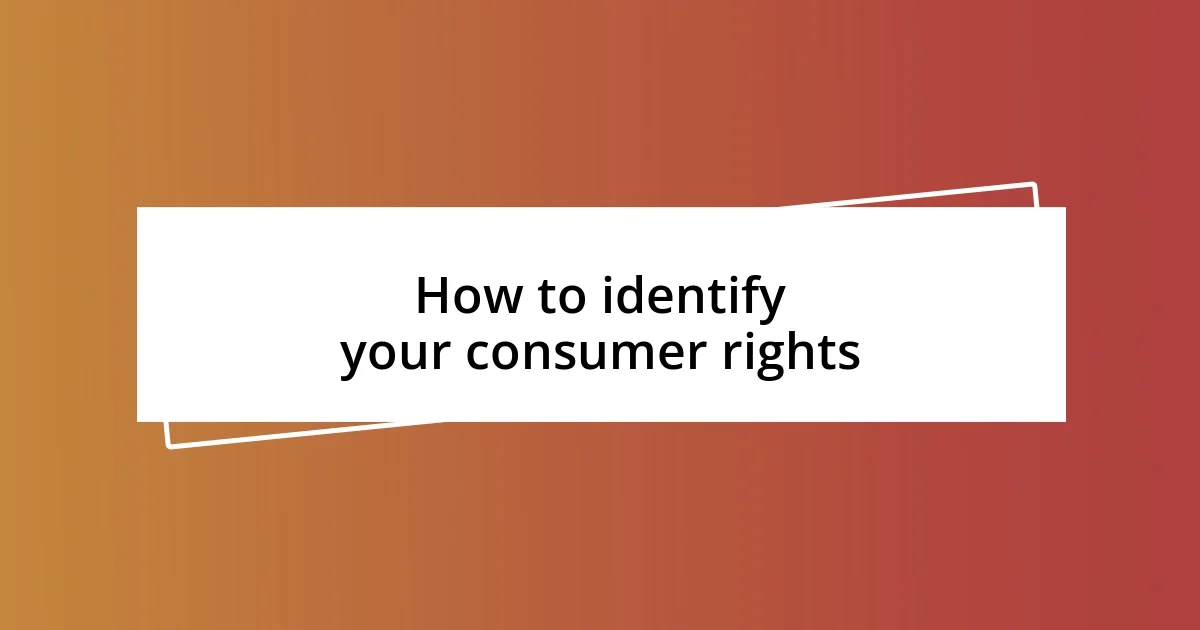Key takeaways:
- Understanding consumer rights encompasses safety, choice, information, and the right to redress, empowering consumers to hold businesses accountable.
- Awareness of consumer rights is crucial for making informed decisions, protecting against deceptive practices, and supporting community advocacy.
- Effective resolution of consumer disputes can involve direct communication with businesses, mediation, and formal complaints, with legal action being a last resort.

Understanding consumer rights basics
Understanding consumer rights is essential for anyone navigating the marketplace today. I remember once feeling frustrated after buying a laptop that malfunctioned shortly after the warranty expired. It was a real wake-up call for me to delve deeper into what rights I actually had as a consumer.
At its core, consumer rights revolve around the principles of safety, choice, and information. Have you ever felt unsure about a purchase? I certainly have, and knowing that I have the right to detailed information helps me make informed decisions that ultimately protect my interests. It’s empowering to realize that you can hold businesses accountable.
Another critical aspect is the right to redress, which means you can seek compensation or rectify a problem if a product or service doesn’t meet expectations. There was a time when I felt overwhelmed by a difficult return process, but understanding this right gave me the confidence to stand my ground. It’s moments like these that reinforce how crucial it is to understand and actively claim our consumer rights.

Importance of consumer rights awareness
Being aware of consumer rights is essential because it empowers individuals to protect themselves in a marketplace filled with countless options and potential pitfalls. I’ll never forget the time I bought a pair of shoes that fell apart just days after purchase. Initially, I felt helpless, but once I learned about my rights regarding faulty products, I confidently approached the retailer for a refund. That experience opened my eyes to how awareness is not just about knowledge; it’s about equipping ourselves to take action.
Here are some key reasons why consumer rights awareness is important:
- Empowerment: Knowing your rights instills confidence when making purchases.
- Control: It allows consumers to hold businesses accountable for their products and services.
- Protection: Being informed minimizes risks associated with deceptive practices.
- Informed decisions: Awareness equips consumers to make better choices, ultimately saving money.
- Advocacy: It fosters a sense of community, as informed consumers can support one another in advocating for fair treatment.
In my journey, I’ve grasped that being aware of consumer rights isn’t just a legal obligation—it’s a path to greater satisfaction and peace of mind in everyday transactions.

Common consumer rights violations
I’ve witnessed firsthand how common consumer rights violations can leave individuals feeling vulnerable. One of the most prevalent issues is false advertising. I once bought a kitchen gadget that promised to make cooking easier, only to find it didn’t function as advertised. It was disheartening to feel misled, highlighting how crucial it is to hold companies accountable for their claims.
Another frequent violation involves defective products, particularly when companies fail to honor warranties. I recall purchasing a smartphone that stopped working within the warranty period, yet the manufacturer insisted it was due to user error. This experience taught me that being diligent about understanding warranty terms is essential, as it’s not uncommon for businesses to sidestep responsibility.
Finally, consider the issue of inadequate customer service. I remember a situation where I tried to return a faulty item, only to face an unfriendly staff member dismissing my concern. It struck me how important it is for consumers to stand firm and demand respectful treatment; every interaction is an opportunity to assert our rights.
| Consumer Rights Violation | Description |
|---|---|
| False Advertising | Marketing claims that misrepresent the product or service. |
| Defective Products | Items that do not work as intended, often leading to warranty disputes. |
| Inadequate Customer Service | Lack of support or respect from employees when addressing issues. |

How to identify your consumer rights
Identifying your consumer rights starts with knowing where to look. I remember feeling overwhelmed the first time I tried to understand them; it seemed like a maze of information. A simple online search on government and consumer protection websites can clarify a lot. These resources often outline what consumers are entitled to regarding faulty products, misleading advertisements, and customer service expectations.
Moreover, talking to others helps demystify consumer rights. Just the other day, I spoke with a friend who shared her experience of dealing with an online retailer. She discovered her rights after joining a consumer advocacy group, which provided her with a wealth of knowledge. It made me realize how sharing experiences can be a powerful tool. Have you ever thought about how a conversation can lead to newfound awareness?
Lastly, don’t underestimate the importance of documentation. I learned this the hard way when a service I purchased failed to deliver as promised. By keeping invoices and receipts, I could reference specific terms and conditions later. This practice reinforced my understanding of my rights and made it easier to argue my case. It’s like having a safety net when things go awry; just knowing you have evidence puts you in a stronger position.

Steps to take when rights are violated
When you discover that your consumer rights have been violated, the first step I recommend is reaching out to the business directly. I recall a time when my bank mistakenly charged me an account fee that I believed was unjust. I called their customer service team, calmly explaining my situation, which led to a quick resolution. It’s amazing how often a simple conversation can set things right.
If the issue persists, don’t hesitate to escalate your complaint to a consumer protection agency. I once heard a friend share how she filed a report about a misleading advertisement that wasted her time and money. She was surprised by the support she received and how seriously the agency took her claim. Have you ever considered the power of your voice when amplified by a governing body?
Lastly, when you’re left with no choice but to take legal action, gathering evidence is crucial. I found this out when dealing with a faulty appliance. I documented everything—from purchase receipts to email correspondence with the manufacturer. The feeling of knowing I was prepared for a potential court case was empowering. What’s your go-to strategy for ensuring you have the right support when things go wrong?

Resources for consumer rights advocacy
I often rely on online databases and organizations dedicated to consumer rights to stay informed. For example, I stumbled upon the Federal Trade Commission’s website, which offers a treasure trove of resources, including guides on specific consumer rights issues. Have you ever visited a site that opened your eyes to something you hadn’t considered before? I certainly did when I discovered their clear breakdown of deceptive business practices.
Local consumer advocacy groups also play a pivotal role in empowering consumers. I once attended a workshop hosted by one such group, and it was enlightening. They provided not only educational resources but also space to connect with others who had experienced similar challenges. The support and camaraderie I felt made me realize we’re not alone in our struggles.
Finally, don’t overlook libraries as a resource for consumer rights advocacy. I was surprised to find an abundance of books and pamphlets on various consumer topics tucked away on the shelves. These materials helped me deepen my understanding and navigate complex issues. Isn’t it comforting to know that knowledge is literally at our fingertips, just waiting to be discovered?

Tools for resolving consumer disputes
When consumer disputes arise, mediation can often work wonders. I remember a time when my coworker faced a significant disagreement with a service provider. Instead of going straight to legal action, she opted for mediation, where a neutral third party helped facilitate discussions. It was a game changer, turning a potentially contentious situation into a collaborative dialogue that ultimately led to a positive resolution.
Another effective tool is the power of writing a formal complaint. I learned this when dealing with a retailer that provided subpar service. Crafting a well-structured letter outlining my grievances brought my concerns to their attention more seriously than casual conversations ever did. Have you ever felt the impact of putting your thoughts down in writing? The clarity it brings can often lead to a swift response.
Lastly, small claims court is an avenue worth considering for disputes that fail to resolve amicably. I’ve chatted with friends who successfully navigated this process after getting nowhere with customer service. It can be intimidating, but it’s often designed to be accessible to consumers without legal representation. Do you think you’d feel confident taking that step if necessary? It’s crucial to weigh your options, as knowing your choices empowers you to act decisively.














